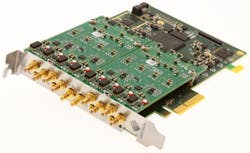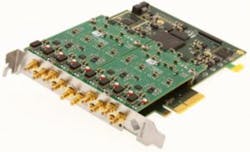Spectrum boosts digitizer maximum sampling rate to 125 MS/s
Grosshansdorf, Germany. Spectrum Instrumentation has announced the addition of five new models to its general-purpose M2p.59xx Series PCIe 16-bit digitizer cards. The new versions extend the performance range by increasing the maximum sampling rate from 80 MS/s up to 125 MS/s. The increased sampling rate, together with higher overall bandwidth, enables the new cards to capture a wider range of electronic signals. It makes them suitable for use in applications where signals in the DC to 50-MHz frequency range need to be acquired and analyzed with speed and accuracy.
Oliver Rovini, CTO at Spectrum, said, “We’re delighted to expand our mid-range digitizer lineup with these new 125-MS/s, 16-bit models. They offer a great combination of speed, accuracy, and performance, all at a very affordable price. We expect they will be very popular in a diverse number of applications such as ultrasound, laser, lidar, radar, power, automotive, medical science, and even big physics experiments.”
The complete product has been packed into a half-length PCIe card, yet it still offers a full set of digitizer features. Each channel has its own programmable input amplifier with ranges between ±200 mV and ±10 V, programmable input offset for unipolar measurements, programmable input termination of 50 Ω and 1 MΩ, and an integrated calibration circuit. Models are available with up to eight single-ended and up to four differential channels.
To match nearly every application requirement, the units come with a variety of signal-triggering techniques, on-board memory of 1 GB, and a number of intelligent acquisition modes, such as multiple recording, gated sampling, or ABA (the combination of fast and slow continuous acquisitions). At just 167 mm long, these multifunction digitizers fit into much smaller PC systems—making them suitable for compact OEM solutions.
Incorporated into the digitizers is a PCIe x4-lane interface that enables fast data streaming at rates of more than 600 MB/s, or more than 80 MS/s continuous streaming for four channels. The cards also support Spectrum’s new SCAPP software option—the Spectrum CUDA Access for Parallel Processing—that opens an easy-to-use yet powerful way to digitize, process, and analyze electronic signals. SCAPP allows a CUDA-based GPU to be used directly between any Spectrum digitizer and the PC. The advantage is that data is passed directly from the digitizer to the GPU, where high-speed parallel processing is possible using its multiple (up to 5,000) processing cores. Fast data streaming and SCAPP can both improve overall measurement speeds and free up vital PC resources.
For high-density, multichannel acquisitions, up to 16 digitizer cards can be fully synchronized using Spectrum’s Star-Hub technology. Star-Hub allows systems to be built with up to 128 channels, all sharing a common clock and trigger in one single chassis. For synchronization with other external equipment, clock and trigger inputs and outputs are also standard. Further flexibility is provided via four individually programmable, front panel connectors that offer additional trigger inputs, status outputs, synchronous digital input lines, asynchronous I/O, or a reference clock input for an integrated time stamping unit.
The software design of the new cards is based on Spectrum’s general driver API that was introduced in 2006. Nowadays more than 400 different products share this common driver library, allowing easy switching from slow to fast products and combining PCIe, PXIe, or Ethernet/LXI products with one common software interface. A complete SDK based on Windows and Linux is included in the delivery. Drivers and examples for nearly every programming language on the market are included leaving the decision of the preferred programming interface to the customer. The current SDK includes C, C++, C#, Delphi, VB.NET, J#, Python, Java, LabVIEW, MATLAB, and LabWindows/CVI.
All units are shipped factory tested and include a base version of Spectrum’s SBench 6 software for first tests and simple measurement tasks. The professional license of the software adds full support for all the acquisition modes, a large number of calculations, additional displays, project control, and reporting.
“The M2p Series products represent the culmination of nearly 30 years of digitizer design and production. As a result, we’re proud to give an industry-leading, five-year warranty on our products,” stated CEO Gisela Hassler. “Furthermore, software and firmware updates are free of charge for the lifetime of the product. Support is done directly by our skilled in-house team of engineers—normally within a couple of hours after receiving the request.”

